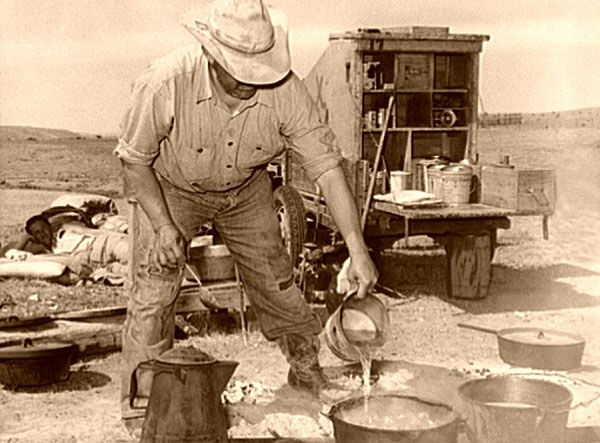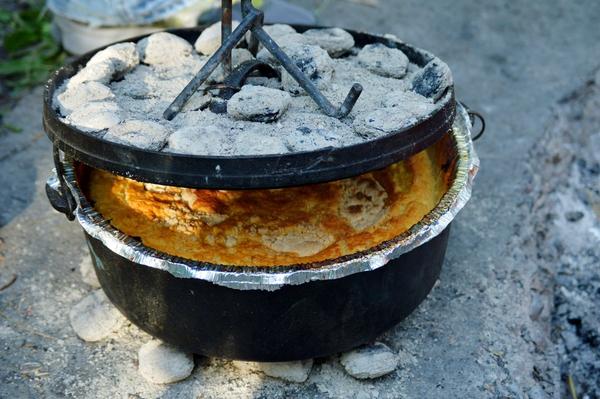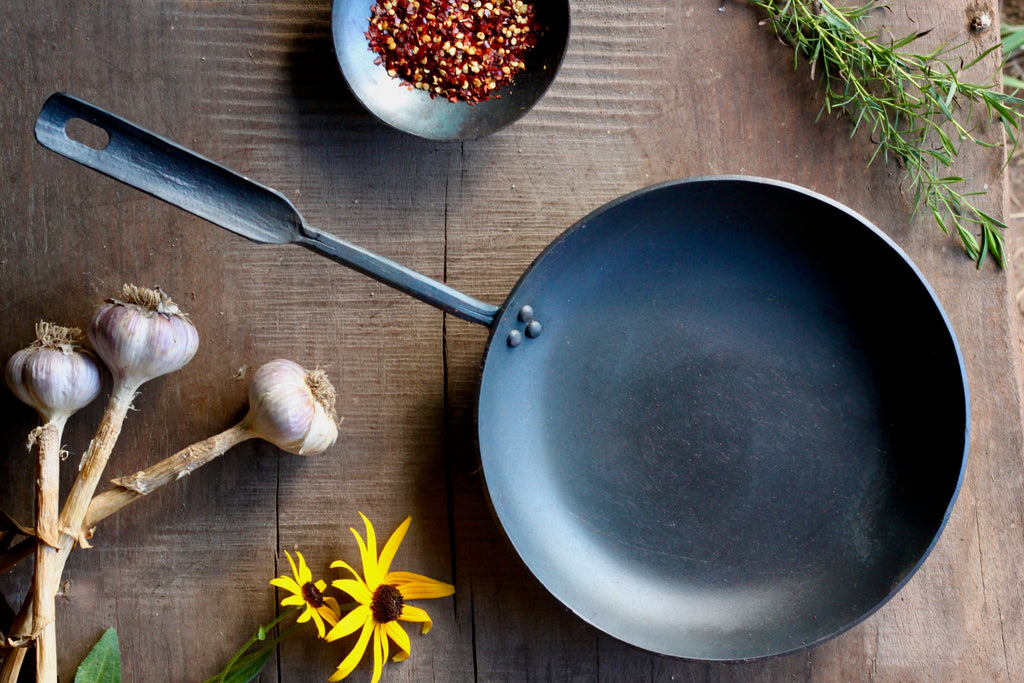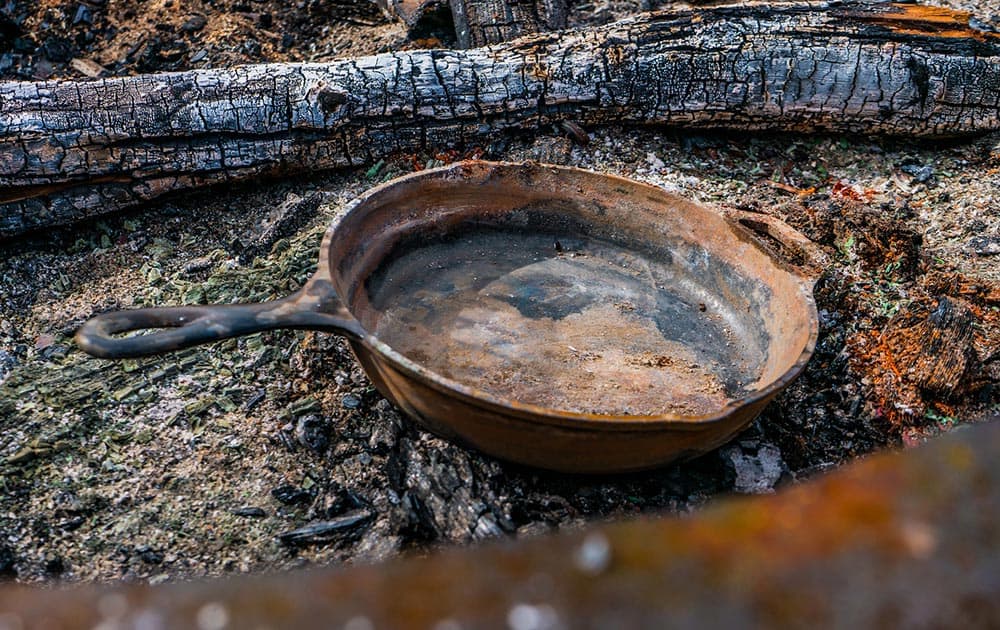
Carbon steel and cast iron cookware are timeless camping gear staples. In fact, cast iron pans and Dutch ovens have been used to cook food over open flames since the days of literal cowboy camping. They were relied upon by cowboys and pioneers heading west across the U.S.
The first recorded use of cast iron cookware dates all the way back to 220 A.D. during the Han Dynasty in China.

Using cast iron cookware for cooking over an open flame is tried, true, and still one of the best methods today. For those who aren’t counting every gram, there’s nothing that compares to carbon steel or cast iron cookware for camping.

Why Is Carbon Steel and Cast Iron the Best Cookware for Camping?
Carbon steel and cast iron possess several traits that make them awesome for cooking over a campfire or portable fire pit.
-
They’re incredibly durable. With proper care, these materials will outlive you.
-
They can be placed directly on/over an open flame and into an oven or campfire.
-
Properly seasoned cast iron and carbon steel develop a non-stick surface for cooking on.
-
Cast iron and carbon steel are easy to clean and low maintenance (if you know what you’re doing… Keep reading!).
What’s the Difference Between Cast Iron and Carbon Steel?
Cast iron and carbon steel are very similar. However, slight differences in their makeup give each material unique characteristics that affect how it functions for cooking.

Carbon steel cookware is made up of (roughly) 99% iron and 1% carbon. This can vary slightly. The lower carbon content makes carbon steel thinner, lighter, and more pliable than cast iron. In terms of cooking, this means that carbon steel responds to both heat and cooling more quickly than cast iron, making it ideal for cooking touchy foods like fried eggs and stir fry.
-
It’s also smoother than cast iron, giving it a slightly more non-stick surface once seasoned.
-
Carbon steel pans have riveted handles that are typically pretty long and conduct less heat.
-
New carbon steel cookware often comes with a beeswax (or similar) coating that needs to be removed using soap and water before seasoning the skillet.
Contrary to what the names may imply, cast iron cookware has a higher carbon content than carbon steel. It’s typically about 97-98% iron and 2-3% carbon. This makes cast iron cookware more brittle — although don’t worry, you’re not going to break it. You can try… It has thicker walls and is heavier and less pliable than carbon steel.
The thicker walls lend themselves to better heat retention. Cast iron pans and skillets lose less heat when cold food is introduced to the pan, lending to a nice crispy sear on meat and fish.
You won’t find riveted handles on cast iron cookware. The handles are forged to the body of the pan. They’re also shorter and tend to get hotter — don’t forget your hot pad holder or fireproof gloves when you’re pulling these bad boys off the fire!
How Are Cast Iron and Carbon Steel Cookware Similar?

Both cast iron and carbon steel cookware…
-
Are durable, versatile, and ideal for searing and browning meats, and sautéing vegetables
-
Need to be seasoned
-
Can last through generations if maintained properly
-
Can be restored if they’ve been neglected, improperly cared for, or have some rust
-
Don’t require dish soap to clean
-
Works great for cooking over the campfire or on your LavaBox
How to Clean, Season, and Care For Cast Iron and Carbon Steel
Well cared for carbon steel and cast iron cookware will hold up through all your adventures and can one day be passed on to your kids and even grandkids! Prepping your carbon steel or cast iron pans to last lifetimes all starts with seasoning them the right way.
If you’re starting with a rusty or neglected piece of cookware, you’re going to want to scrub away the rust before seasoning. All you’ll need are a few items you probably already have in your kitchen.

How To Remove Rust From Cast Iron Cookware
You’ll need a box of coarse kosher salt, a potato with one end cut off, and, optionally, a chain mail scrubber for good measure.
-
Pour a hefty amount of kosher salt onto the rusted surface of the (dry!) cast iron.
-
Use the part of the potato that’s still covered by the skin as a handle, while using the flat, cut end of the potato to rub the salt into the pan and scrub away the rust.
-
Dump the old salt out and repeat with refreshed salt as needed.
-
After the rust is removed, dump any leftover salt and rinse the cast iron with warm water.
-
Pat dry with a clean paper towel, then place the cast iron upside down in an oven preheated to 250℉ for 5 minutes to evaporate any lingering moisture before seasoning.
Restoring Carbon Steel Cookware
So, you put your favorite carbon steel wok away while it was damp, and now it has rust spots? Shame, shame… but no worries!
Removing rust from carbon steel is very similar to restoring cast iron cookware. However, instead of salt and a potato, all you need is steel wool or a chain mail sponge as both the abrasive agent and the scrubber.
-
Run your faucet as hot as your hands can handle.
-
Place the rusted carbon steel cookware under the running water.
-
Use the steel wool or chain mail to scrub away the rust.
-
*Optional Step* If there are still signs of rust or gunk on the pan, pour some hot water and white vinegar into the cooking surface and allow it to sit for 5 minutes before rinsing.
-
Pat dry with a paper towel and place the pan on a burner set to low/medium heat for 5 minutes to dry before seasoning.
Don’t stress about scratching your cookware. Carbon steel is tough. It’s nearly impossible to get this process wrong. In most cases, you’d even be safe using sandpaper to scrub away the rust! The seasoning you’re about to add to the pan makes this a very forgiving process.
Once you’ve removed any rust from the cooking surface, bottom, walls, and handle of your carbon steel or cast iron cookware, it’s time for the Pièce de résistance… Seasoning!
Step by Step: How to Season Cast Iron Cookware
For carbon steel, check out THIS video.
The seasoning process is the special sauce that makes your cast iron or carbon steel cookware non-stick, more resistant to rust, and able to last a lifetime! It’s an easy, although time-consuming process. Make sure you have time to do it right and that you don’t need to use your oven for anything else in the meantime.

How to season cast iron and carbon steel cookware the right way:
-
Use an oil with a smoke point above 450℉. I recommend avocado oil, but flaxseed, grapeseed, and canola oil also work.
-
Pour a dime to a nickel-sized (very small) amount of oil on the cooking surface of the carbon steel or cast iron pan. The key here is that you probably need much less oil than you think you do…
-
Use a clean, dry paper towel or lint-free kitchen towel to rub the oil into the entirety of the pan — assuring to coat every face, nook, and cranny, including the handle. (Unless you’re working with a carbon steel pan that has a handle made up of a different material.)
-
Wipe off any excess oil with a separate clean, dry paper towel.
-
Place the carbon steel or cast iron cookware upside down on the top rack of an oven preheated to 450℉.
-
Place a baking sheet underneath on the bottom rack to catch excess oil. However, there should be minimal to no excess oil if you completed steps 2 and 3 without overdoing it.
-
Let him cook!... for 30 minutes.
-
Remove the skillet and let it cool on a drying rack.
-
Once cool to the touch, repeat this process about three times until cast iron is glossy yet dry to the touch and carbon steel achieves a beautiful bronze sheen.
Once you’ve achieved a perfectly seasoned carbon steel or cast iron pan, skillet, wok, or dutch oven, it’s time to maintain the seasoning. Eventually, you’ll have to re-season your cookware again, but with proper care for your cast iron and carbon steel — particularly when cleaning — you shouldn’t have to worry about it anytime soon.
Well seasoned carbon steel and cast iron are very functional and low-maintenance. That’s part of why we love these materials for camping!
How To Clean and Store Carbon Steel and Cast Iron Cookware
It’s a contentious issue, and if you know nothing else about cooking on cast iron, you’ve probably heard the commotion about never touching it with dish soap.
Folks get a little dramatic about this and, to be honest, if you’re pan is well seasoned, dish soap won’t hurt it as long as you dry the pan completely right after washing. However, it’s also not necessary.

There are less controversial, lower maintenance methods for cleaning out carbon steel and cast iron cookware that we prefer — especially for camping.
Whether Caring for Cast Iron or Carbon Steel, This Cleaning Method Works Flawlessly
-
Clean cast iron and carbon steel cookware immediately after use once cool enough to handle.
-
Dispose of any oil or fat built up inside the pan.
-
Use a dry paper towel, sponge, or kosher salt or our favorite, chain mail, to scrub out any stuck bits of food.
-
Use a wooden spatula to scrape off stubborn baked-on gunk.
-
If your pan is free of stuck-on food... Skip to step 8.
-
*Optional Step* If there’s still crap stuck to the pan, fill the pan with about 1” of water and boil it over the campfire or a burner to loosen the stuck food. Scrape it off with the edge of a wooden spatula.
-
*Optional Step* If you did step 6, dump the water out, give the pan a quick rinse, and use a paper towel to dry the pan completely.
-
If the carbon steel or cast iron was exposed to moisture while being cleaned, put the cookware on a grate over a campfire or on a low/medium flame for 5 minutes to ensure it’s completely dry before storing.
-
*Optional Step* If your pan is starting to lose its sheen, use a paper towel to wipe it down with a drop of oil before storing to preserve the seasoning. Finish the job with a final wipe down using a dry paper towel.
-
Store carbon steel and cast iron cookware somewhere it won’t be exposed to moisture.
Carbon Steel and Cast Iron Make the Best Cookware for Camping

Yes, they require a little bit of elbow grease upfront — especially if you’re restoring old cast iron or carbon steel that wasn’t given the love it deserved. However, once you’ve done the groundwork and prepped your carbon steel or cast iron cookware with a good few coats of seasoning, these are super durable, versatile pieces of cookware that are great for camping. In most cases, you don’t even need water or soap to clean them!
We also highly recommend using cast iron or carbon steel when cooking over your LavaBox. This is why our bestselling Skwok (skillet/wok) is constructed of hand-forged carbon steel. It’s not just useful for camping; the Skwok is a chef-designed, heritage piece of cookware that you’ll be able to enjoy for generations to come.

